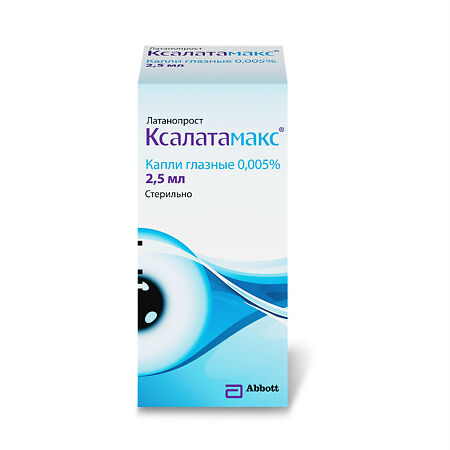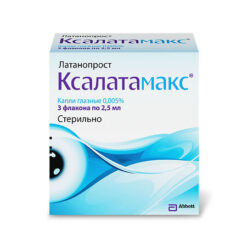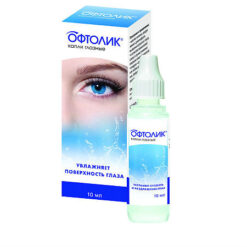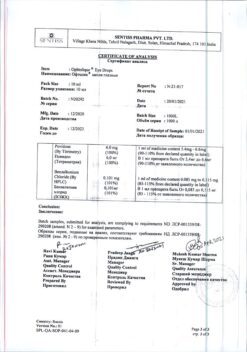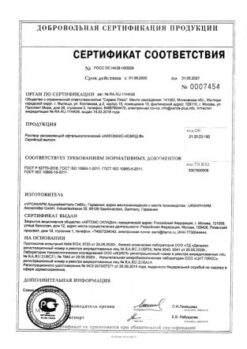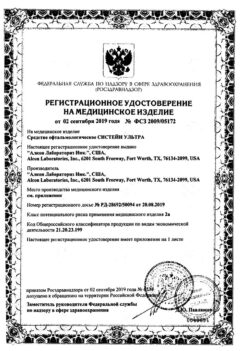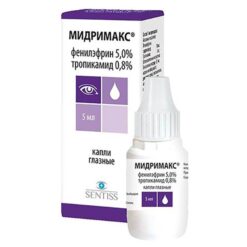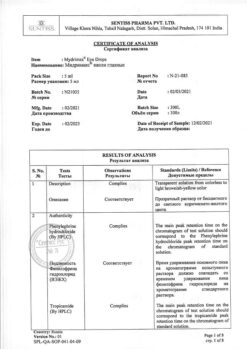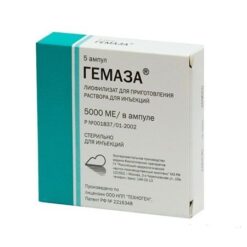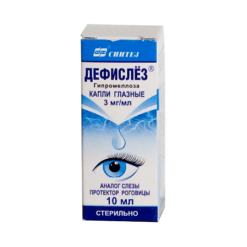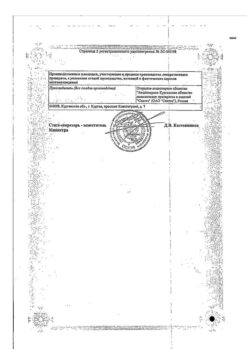No products in the cart.
Xalatamax, eye drops 0.005%, 2.5ml
€20.82 €17.35
Description
Antiglaucoma drug for topical use. Latanoprost is an analogue of prostaglandin F2α and a selective agonist of FP-receptors. By increasing the outflow of aqueous humor, it reduces intraocular pressure and has an anti-glaucoma effect. The main mechanism of action is to increase uveoscleral outflow. It has no significant effect on the production of aqueous humor and does not affect the heme-ophthalmic barrier.
The decrease of intraocular pressure starts 3-4 hours after the drug is injected; the maximal effect is registered after 8-12 hours; the duration of action is at least 24 hours.
Pharmacokinetics
Intake
It penetrates well through the cornea, with hydrolysis of latanoprost to its biologically active form – latanoprost acid. Cmax of latanoprost in aqueous humor is reached approximately 2 hours after topical application of the drug.
Latanoprost acid is virtually unmetabolized in the tissues of the eye; metabolism occurs primarily in the liver.
Metabolism and excretion
T1/2 is 17 min. The major metabolites, 1,2-dinor- and 1,2,3,4-tetranor-metabolites, have no or little biological activity and are excreted by the kidneys.
Indications
Indications
Reduction of elevated intraocular pressure (IOP) in adults and children (over 1 year of age) with open-angle glaucoma or increased intraocular tone.
Pharmacological effect
Pharmacological effect
Antiglaucoma drug for local use. Latanoprost is a prostaglandin F2α analog and a selective FP receptor agonist. By increasing the outflow of aqueous humor, it reduces intraocular pressure and has an antiglaucoma effect. The main mechanism of action is an increase in uveoscleral outflow. It does not have a significant effect on the production of aqueous humor and does not affect the blood-ophthalmic barrier.
The decrease in intraocular pressure begins 3-4 hours after administration of the drug, the maximum effect is observed after 8-12 hours, the duration of action is at least 24 hours.
Pharmacokinetics
Suction
Penetrates well through the cornea, and hydrolysis of latanoprost occurs to the biologically active form – latanoprost acid. Cmax of latanoprost in aqueous humor is achieved approximately 2 hours after topical administration of the drug.
In the tissues of the eye, latanoprost acid is practically not metabolized; metabolism occurs mainly in the liver.
Metabolism and excretion
T1/2 is 17 min. The main metabolites – 1,2-dinor- and 1,2,3,4-tetranor-metabolites do not have or have weak biological activity and are excreted by the kidneys.
Special instructions
Special instructions
Latanoprost may cause a gradual change in eye color by increasing the amount of brown pigment in the iris. This effect is detected predominantly in patients with mixed iris color, for example, blue-brown, gray-brown, green-brown or yellow-brown, which is explained by an increase in the melanin content in the stromal melanocytes of the iris.
Typically, brown pigmentation extends concentrically around the pupil to the periphery of the iris, and the entire iris or parts of it may become a more intense brown color. In patients with evenly colored eyes of blue, grey, green or brown, changes in eye color were observed very rarely after two years of use of the drug. The color change is not accompanied by any clinical symptoms or pathological changes. After discontinuation of the drug, no further increase in the amount of brown pigment was observed, however, the color change that has already developed may be irreversible. In the presence of nevi or lentigines on the iris, no changes were noted under the influence of therapy.
Before starting treatment, patients should be informed about the possibility of changes in eye color. In case of intense changes in eye pigmentation, treatment may be discontinued. Treatment of only one eye can lead to permanent heterochromia.
Latanoprost can cause gradual changes in eyelashes and vellus hairs, such as lengthening, thickening, increased pigmentation, increased thickness, and a change in the direction of eyelash growth. Changes in eyelashes are reversible and disappear after cessation of treatment.
The drug contains benzalkonium chloride, which can be absorbed into contact lenses. When using contact lenses, you should remove them before instillation and put them back on no earlier than 15-20 minutes after instillation of the drug.
The bottle must be closed after each use.
Do not touch the tip of the pipette to your eye.
Impact on the ability to drive vehicles and operate machinery
Patients who experience transient blurred vision after using eye drops are advised not to drive or operate moving machinery until vision returns.
Active ingredient
Active ingredient
Latanoprost
Composition
Composition
1 ml contains:
Active substances:
latanoprost 0.05 mg;
Excipients:
benzalkonium chloride – 200 mcg,
sodium dihydrogen phosphate monohydrate – 4.6 mg,
sodium hydrogen phosphate – 4.74 mg,
sodium chloride – 4.1 mg,
purified water – 996.31 mg.
Pregnancy
Pregnancy
Use during pregnancy is contraindicated.
If it is necessary to use the drug, breastfeeding should be stopped.
No effect of latanoprost on male or female fertility was found in animal studies.
Contraindications
Contraindications
Hypersensitivity to latanoprost or other components of the drug.
Age up to 1 year (efficacy and safety have not been established).
Side Effects
Side Effects
From the organ of vision: Eye irritation (burning sensation, feeling of sand in the eyes, itching, tingling and foreign body sensation), blepharitis, conjunctival hyperemia, eye pain, increased pigmentation of the iris, transient pinpoint erosion of the epithelium, swelling of the eyelids, swelling and erosion of the cornea, conjunctivitis, elongation, thickening, increase in the number and increase in pigmentation of eyelashes and vellus hair, iritis/uveitis, keratitis, macular edema (including cystoid), change in the direction of eyelash growth, sometimes causing eye irritation, blurred vision.
Dermatological reactions: Rash, darkening of the skin of the eyelids and local skin reactions of the eyelids.
From the nervous system: Dizziness, headache.
From the respiratory system: Bronchial asthma (including acute attacks or exacerbation of the disease in patients with a history of bronchial asthma), shortness of breath.
From the musculoskeletal system: Muscle pain, joint pain.
Other6 Nonspecific chest pain.
Interaction
Interaction
Latanoprost has an additive effect in lowering intraocular pressure when used in combination with beta-blockers, adrenergic agonists, carbonic anhydrase inhibitors and a partial additive effect when used in combination with m-cholinomimetics.
In vitro studies have shown that when thiomersal-containing eye drops are mixed with latanoprost, precipitation occurs. Therefore, eye drops containing these substances should be used at intervals of at least 5 minutes.
The simultaneous use of 2 prostaglandin analogues can cause a paradoxical increase in intraocular pressure.
Overdose
Overdose
In case of overdose, symptomatic treatment is carried out.
Apart from irritation of the mucous membrane of the eyes, hyperemia of the conjunctiva or episclera, other undesirable changes in the organ of vision are not known with an overdose of latanoprost.
Storage conditions
Storage conditions
Store in a place protected from light at a temperature of 2 to 8 °C.
Store the opened bottle at a temperature not exceeding 25 °C.
Keep out of the reach of children.
Shelf life
Shelf life
1 year
Manufacturer
Manufacturer
JADRAN-GALENSKI LABORATORY j.s., Croatia
Additional information
| Shelf life | 1 year |
|---|---|
| Conditions of storage | Store in a dark place at temperatures from 2 to 8 ° C. Opened bottle should be stored at a temperature not exceeding 25 ° C. Keep out of reach of children. |
| Manufacturer | JADRAN-GALENSKI LABORATORY a.s., Croatia |
| Medication form | eye drops |
| Brand | JADRAN-GALENSKI LABORATORY a.s. |
Other forms…
Related products
Buy Xalatamax, eye drops 0.005%, 2.5ml with delivery to USA, UK, Europe and over 120 other countries.

